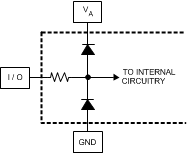JAJSDJ8A April 2017 – October 2021 ADC12D1620QML-SP
PRODUCTION DATA
- 1 特長
- 2 アプリケーション
- 3 概要
- 4 Revision History
- 5 Pin Configuration and Functions
-
6 Specifications
- 6.1 Absolute Maximum Ratings
- 6.2 ESD Ratings
- 6.3 Recommended Operating Conditions
- 6.4 Thermal Information
- 6.5 Converter Electrical Characteristics: Static Converter Characteristics
- 6.6 Converter Electrical Characteristics: Dynamic Converter Characteristics
- 6.7 Converter Electrical Characteristics: Analog Input/Output and Reference Characteristics
- 6.8 Converter Electrical Characteristic: Channel-to-Channel Characteristics
- 6.9 Converter Electrical Characteristics: LVDS CLK Input Characteristics
- 6.10 Electrical Characteristics: AutoSync Feature
- 6.11 Converter Electrical Characteristics: Digital Control and Output Pin Characteristics
- 6.12 Converter Electrical Characteristics: Power Supply Characteristics
- 6.13 Converter Electrical Characteristics: AC Electrical Characteristics
- 6.14 Electrical Characteristics: Delta Parameters
- 6.15 Timing Requirements: Serial Port Interface
- 6.16 Timing Requirements: Calibration
- 6.17 Quality Conformance Inspection
- 6.18 Timing Diagrams
- 6.19 Typical Characteristics
-
7 Detailed Description
- 7.1 Overview
- 7.2 Functional Block Diagram
- 7.3 Feature Description
- 7.4 Device Functional Modes
- 7.5
Programming
- 7.5.1
Control Modes
- 7.5.1.1
Non-ECM
- 7.5.1.1.1 Dual-Edge Sampling Pin (DES)
- 7.5.1.1.2 Non-Demultiplexed Mode Pin (NDM)
- 7.5.1.1.3 Dual Data-Rate Phase Pin (DDRPh)
- 7.5.1.1.4 Calibration Pin (CAL)
- 7.5.1.1.5 Low-Sampling Power-Saving Mode Pin (LSPSM)
- 7.5.1.1.6 Power-Down I-Channel Pin (PDI)
- 7.5.1.1.7 Power-Down Q-Channel Pin (PDQ)
- 7.5.1.1.8 Test-Pattern Mode Pin (TPM)
- 7.5.1.1.9 Full-Scale Input-Range Pin (FSR)
- 7.5.1.1.10 AC- or DC-Coupled Mode Pin (VCMO)
- 7.5.1.1.11 LVDS Output Common-Mode Pin (VBG)
- 7.5.1.2 Extended Control Mode
- 7.5.1.1
Non-ECM
- 7.5.1
Control Modes
- 7.6 Register Maps
- 8 Application Information Disclaimer
- 9 Power Supply Recommendations
- 10Layout
- 11Device and Documentation Support
- 12Mechanical, Packaging, and Orderable Information
6.8 Converter Electrical Characteristic: Channel-to-Channel Characteristics
The following specifications apply after calibration for VA =
VDR = VTC = VE = 1.9 V; I and Q channels
AC-coupled, FSR pin = high; CL = 10 pF; differential AC-coupled sine
wave input clock, fCLK = 1.6 GHz at 0.5 VP-P with 50% duty
cycle; VBG = floating; non-extended control mode; Rext = Rtrim = 3300
Ω ±0.1%; analog signal source impedance = 100-Ω differential; 1:2 demultiplex
non-DES mode; I and Q channels; duty-cycle stabilizer on.(1)(2)
| PARAMETER | CONDITIONS | SUB-GROUPS | MIN | TYP(3) | MAX | UNIT | |
|---|---|---|---|---|---|---|---|
| Phase matching (I, Q) | fIN = 1 GHz | < 1 | Degree | ||||
| X-TALK Q-channel |
Crosstalk from I channel (aggressor) to Q channel (victim) | Aggressor = 248 MHz | –72 | dBFS | |||
| Aggressor = 498 MHz | –75 | dBFS | |||||
| X-TALK I-channel |
Crosstalk from Q channel (aggressor) to I channel (victim) | Aggressor = 248 MHz | –71 | dBFS | |||
| Aggressor = 498 MHz | –79 | dBFS |
(1) The analog inputs are protected as shown below. Input voltage
magnitudes beyond the Absolute Maximum Ratings may damage this device.


(2) To ensure accuracy, it is required that VA,
VTC, VE and VDR be well bypassed. Each supply
pin must be decoupled with separate bypass capacitors.
(3) Typical figures are at TA = 25°C, and represent most
likely parametric norms. Test limits are ensured to Texas Instrument's average
outgoing quality level (AOQL).